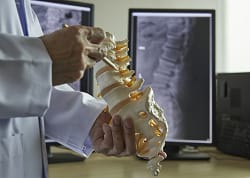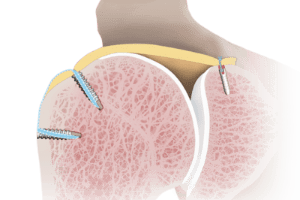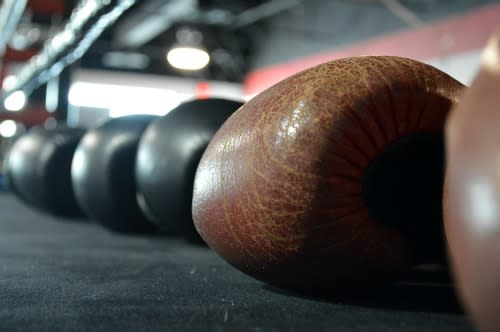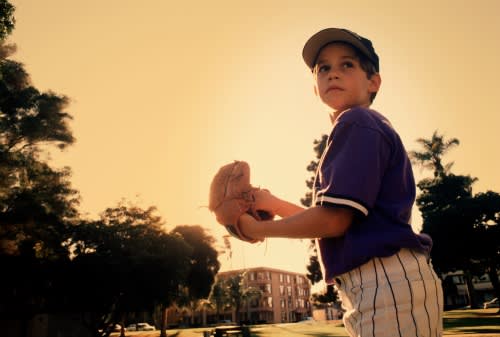Overhead throwing injuries are typically due to overuse and can affect different structures in the shoulder. The rotator cuff, labrum and capsule are just a few of the main structures in the shoulder that can be affected by repetitive overhead motions.
The most common type of overhead throwing injuries involve the rotator cuff, a group of tendons that cross the shoulder joint and help it to rotate. An injury to this area can range from irritation or inflammation of the tendons, initially feeling similar to painful tendonitis, to a partial tear which can occur over time and progress to a complete tear. Athletes who can suffer from this type of injury include almost any “overhead” athlete such as baseball, volleyball, lacrosse and football players, as well as swimmers. In fact, almost 80% of elite- level swimmers will experience some type of shoulder injury in their career.
At the first sign of pain, an athlete should refrain from sports activity and rest immediately. If the rotator cuff is inflamed and irritated, rest, physical therapy and anti-inflammatory medication can help relieve the pain. Partial tears and even some full thickness tears may only require the patient to rest, take anti-inflammatory medication and perhaps some physical therapy in lieu of surgery, depending on symptoms. Depending on the patient’s level of function, a cortico-steroid injection might also be recommended. A full thickness tear is the most severe rotator cuff injury. Depending on age and functional demands, some people may be able to function quite well without surgery. For younger individuals and athletes, arthroscopic surgical repair of the tendon is often felt to be the best option to restore as much function as possible.
Non-operative treatment will typically keep a patient out of play anywhere from two to six weeks. If surgical repair is deemed necessary, the tendon will need time to heal in the repaired state for a minimum of three to five months before the patient can begin any significant activity. For high-level athletes, it may take even longer.
Physical therapy is an important part of the treatment process. Therapy comes in three phases, the first of which is meant to restore basic motion, and can take one to two months. Once most of a patient’s motion is restored, therapists will focus on rebuilding the strength in the shoulder. The final stage of physical therapy focuses on getting a patient back into his or her “sports-specific” routine.
Athletes can experience shoulder injuries for a number of different reasons. Poor form and improper technique as well as overuse or repeated stress can all put the shoulder at risk for injury. For example, baseball pitchers are using the same motion over and over again, sometimes over 100 times per game. These injuries occur in greatest frequency during the mid-to-late teen years as the shoulder is subjected to progressively higher stress with increasing muscular development. Athletes often play on multiple teams, and never seem to count “practice” sessions among the total amount of use. Paying close attention to “pitch counts” can go a long way to limit injury.
To prevent overhead injuries from occurring, it is important to have good flexibility and range of motion. An athlete should always complete stretching exercises and a sport-specific warm-up routine, which helps to gradually increase blood circulation throughout the muscles, tendons and ligaments. Also, it is important to develop good form, which will largely help to reduce the rate of injury (both of the shoulder and elbow). Proper technique involves training and developing the “core” and lower body musculature which has been shown to improve throwing performance.
Another factor that affects overall orthopedic health and recovery from injury is proper nutrition and the avoidance of tobacco (both the smoking and smokeless varieties). In addition to the well-known affliction of lung cancer, other maladies such as oral cancer, COPD and emphysema, are also associated with smoking and nicotine products. Nicotine constricts the blood vessels resulting in diminished blood flow, which is critical for healing and maintaining nutrition to the muscles, tendons, ligaments and bone. Should an injury occur in a person that smokes or uses nicotine products, that injury has the potential of delayed or even incomplete healing. In fact, there are several orthopedic conditions in which surgical treatment options are questionable due to the high rate of failure in nicotine users.
The most common type of overhead throwing injuries involve the rotator cuff, a group of tendons that cross the shoulder joint and help it to rotate. An injury to this area can range from irritation or inflammation of the tendons, initially feeling similar to painful tendonitis, to a partial tear which can occur over time and progress to a complete tear. Athletes who can suffer from this type of injury include almost any “overhead” athlete such as baseball, volleyball, lacrosse and football players, as well as swimmers. In fact, almost 80% of elite- level swimmers will experience some type of shoulder injury in their career.
At the first sign of pain, an athlete should refrain from sports activity and rest immediately. If the rotator cuff is inflamed and irritated, rest, physical therapy and anti-inflammatory medication can help relieve the pain. Partial tears and even some full thickness tears may only require the patient to rest, take anti-inflammatory medication and perhaps some physical therapy in lieu of surgery, depending on symptoms. Depending on the patient’s level of function, a cortico-steroid injection might also be recommended. A full thickness tear is the most severe rotator cuff injury. Depending on age and functional demands, some people may be able to function quite well without surgery. For younger individuals and athletes, arthroscopic surgical repair of the tendon is often felt to be the best option to restore as much function as possible.
Non-operative treatment will typically keep a patient out of play anywhere from two to six weeks. If surgical repair is deemed necessary, the tendon will need time to heal in the repaired state for a minimum of three to five months before the patient can begin any significant activity. For high-level athletes, it may take even longer.
Physical therapy is an important part of the treatment process. Therapy comes in three phases, the first of which is meant to restore basic motion, and can take one to two months. Once most of a patient’s motion is restored, therapists will focus on rebuilding the strength in the shoulder. The final stage of physical therapy focuses on getting a patient back into his or her “sports-specific” routine.
Athletes can experience shoulder injuries for a number of different reasons. Poor form and improper technique as well as overuse or repeated stress can all put the shoulder at risk for injury. For example, baseball pitchers are using the same motion over and over again, sometimes over 100 times per game. These injuries occur in greatest frequency during the mid-to-late teen years as the shoulder is subjected to progressively higher stress with increasing muscular development. Athletes often play on multiple teams, and never seem to count “practice” sessions among the total amount of use. Paying close attention to “pitch counts” can go a long way to limit injury.
To prevent overhead injuries from occurring, it is important to have good flexibility and range of motion. An athlete should always complete stretching exercises and a sport-specific warm-up routine, which helps to gradually increase blood circulation throughout the muscles, tendons and ligaments. Also, it is important to develop good form, which will largely help to reduce the rate of injury (both of the shoulder and elbow). Proper technique involves training and developing the “core” and lower body musculature which has been shown to improve throwing performance.
Another factor that affects overall orthopedic health and recovery from injury is proper nutrition and the avoidance of tobacco (both the smoking and smokeless varieties). In addition to the well-known affliction of lung cancer, other maladies such as oral cancer, COPD and emphysema, are also associated with smoking and nicotine products. Nicotine constricts the blood vessels resulting in diminished blood flow, which is critical for healing and maintaining nutrition to the muscles, tendons, ligaments and bone. Should an injury occur in a person that smokes or uses nicotine products, that injury has the potential of delayed or even incomplete healing. In fact, there are several orthopedic conditions in which surgical treatment options are questionable due to the high rate of failure in nicotine users.
Featured Expert/ Author























